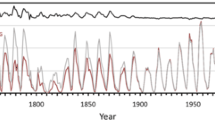Abstract
In this paper, we construct a time series known as the Group Sunspot Number. The Group Sunspot Number is designed to be more internally self-consistent (i.e., less dependent upon seeing the tiniest spots) and less noisy than the Wolf Sunspot Number. It uses the number of sunspot groups observed, rather than groups and individual sunspots. Daily, monthly, and yearly means are derived from 1610 to the present. The Group Sunspot Numbers use 65941 observations from 117 observers active before 1874 that were not used by Wolf in constructing his time series. Hence, we have calculated daily values of solar activity on 111358 days for 1610–1995, compared to 66168 days for the Wolf Sunspot Numbers. The Group Sunspot Numbers also have estimates of their random and systematic errors tabulated. The generation and preliminary analysis of the Group Sunspot Numbers allow us to make several conclusions: (1) Solar activity before 1882 is lower than generally assumed and consequently solar activity in the last few decades is higher than it has been for several centuries. (2) There was a solar activity peak in 1801 and not 1805 so there is no long anomalous cycle of 17 years as reported in the Wolf Sunspot Numbers. The longest cycle now lasts no more than 15 years. (3) The Wolf Sunspot Numbers have many inhomogeneities in them arising from observer noise and this noise affects the daily, monthly, and yearly means. The Group Sunspot Numbers also have observer noise, but it is considerably less than the noise in the Wolf Sunspot Numbers. The Group Sunspot Number is designed to be similar to the Wolf Sunspot Number, but, even if both indices had perfect inputs, some differences are expected, primarily in the daily values.
Similar content being viewed by others
References
Baiada, E. and Merighi, R.: 1982, Solar Phys. 77, 357.
Carrington, R. C.: 1860, Monthly Notices Royal Astron. Soc. 20, 71.
Chevallier, T.: 1847–1849, Drawings of Sunspots, Manuscript, RAS Library, London.
Hossfield, C. H.: 1997, JAAVSO 26(1).
Hoyt, D. V. and Schatten, K. H.: 1994, Geophys. Res. Letters 21, 2067.
Hoyt, D. V. and Schatten, K. H.: 1995, Solar Phys. 160, 393.
McKinnon, J. A.: 1986, Sunspot Numbers 1610–1985, Report UAG-95, WDC-A, Boulder, CO.
Musano, M.: 1742, Raccato d Opuscoli Scientifici a Filogiri 50, 299.
Waldmeier, M.: 1961, The Sunspot Activity in the Years 1610–1960, Schulthess & Company AG, Zürich.
Wolf, R.: 1861, Mitt. Sonnenflecken 2, 72.
Wolf, R.: 1858–1893, Astron. Mitt., all issues.
Zinner, E.: 1952, Naturf. Ges. Bamberg 33, 36.
Author information
Authors and Affiliations
Rights and permissions
About this article
Cite this article
Hoyt, D.V., Schatten, K.H. Group Sunspot Numbers: A New Solar Activity Reconstruction. Solar Physics 179, 189–219 (1998). https://doi.org/10.1023/A:1005007527816
Issue Date:
DOI: https://doi.org/10.1023/A:1005007527816




